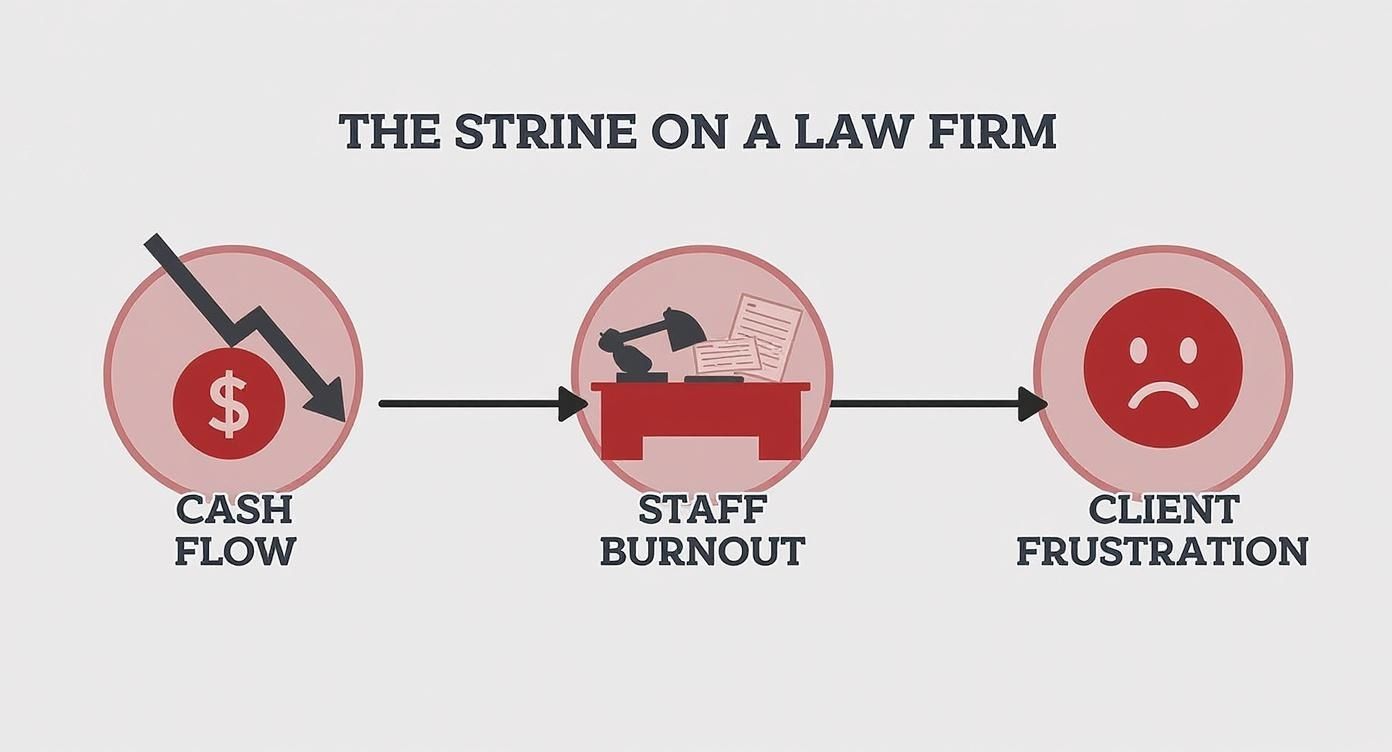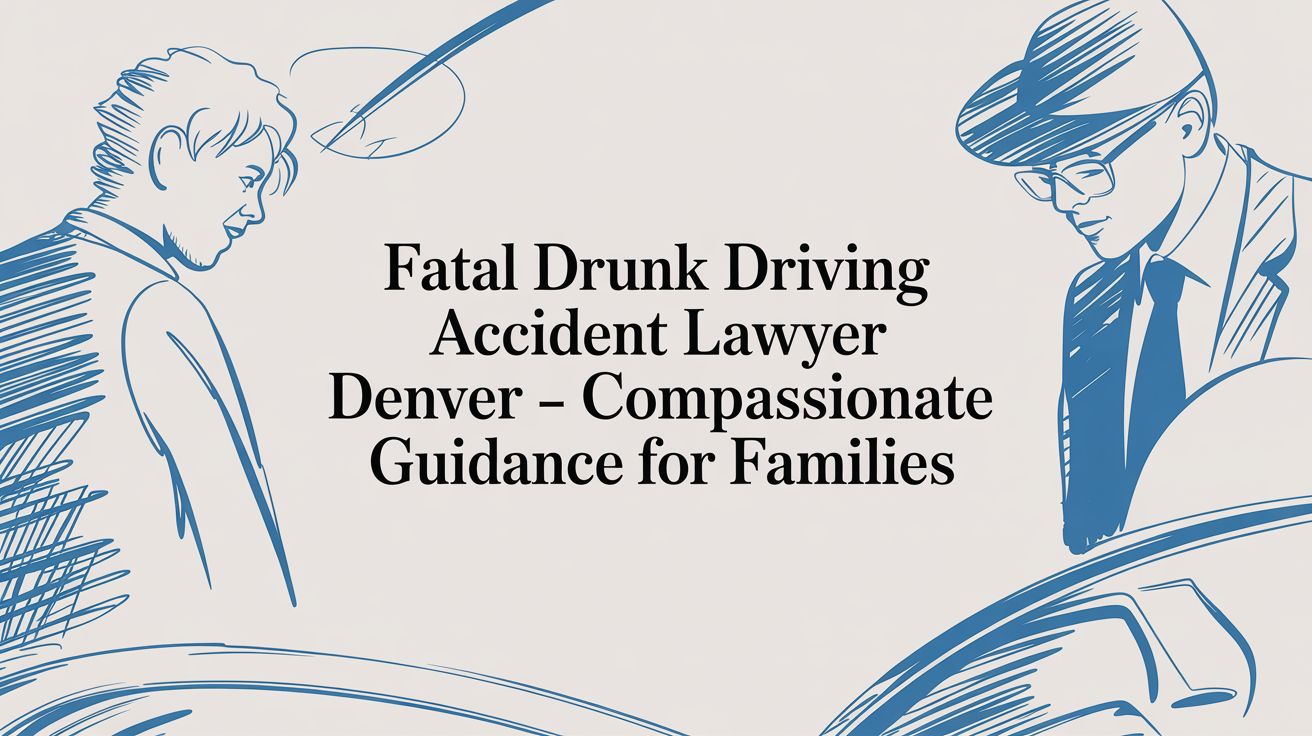Table of Contents
It's the first question every new personal injury client asks: "How long is this going to take?" For them, it's a simple query driven by anxiety. For your law firm, it reveals a core operational challenge. The honest answer—it depends—satisfies no one and highlights the unpredictability that strains your firm’s cash flow, resources, and team morale. While a simple car accident case might resolve in months, a complex claim can stretch for years.
This uncertainty isn't just a client management issue; it's a direct threat to your firm's growth. But you have more control than you think. By implementing robust systems, you can streamline your operations, reduce unnecessary delays, and provide clients with the confident, clear answers they deserve. This guide will show you how.
The Challenge: Why Unpredictable Timelines Strain Your Firm

For a contingency-fee personal injury firm, the question "how long does a personal injury claim take?" is directly tied to financial stability. When case timelines are unpredictable, so is your revenue. This forces you into a reactive management style, making it impossible to strategically plan for hiring, marketing, or technology investments. You're left managing cash flow by guesswork, putting out fires instead of building for the future.
This operational friction creates a ripple effect that harms your firm in three critical ways:
- Financial Instability: Inconsistent settlements make revenue forecasting a constant challenge, hindering your ability to scale.
- Team Burnout: Your staff spends countless hours on low-value, repetitive tasks like chasing medical records, manually tracking case progress, and answering repetitive client calls. This administrative drag is a direct path to employee turnover.
- Poor Client Experience: When clients feel uninformed, their frustration grows. This leads to constant "checking in" calls that drain your team's time and can result in negative online reviews, damaging your firm's reputation.
These are not just the costs of doing business; they are symptoms of a deeper problem—a lack of scalable internal systems. Without a structured process, your firm remains stuck reacting to external events instead of proactively controlling its own workflows and driving cases toward resolution.
The Solution: Taking Control with System-Driven Workflows

While you can't control insurance adjusters or court dockets, you have absolute authority over your internal operations. The solution is to shift from manual, ad-hoc processes to automated, system-driven workflows. This transformation allows your firm to manage case timelines proactively, ensuring consistency, efficiency, and a superior client experience.
Automation acts as a force multiplier for your team. It handles the repetitive, administrative tasks, freeing up your skilled paralegals and case managers to focus on high-value work that moves cases forward. By building a predictable, repeatable playbook for every stage of a claim, you eliminate the internal chaos that causes unnecessary delays.
This shift has three primary benefits:
- Reduced Administrative Drag: Automated follow-ups for medical records and streamlined document management save hundreds of hours per year.
- Proactive Client Communication: Automated milestone updates keep clients informed, building trust and drastically reducing inbound status-check calls.
- Improved Case Velocity: With smoother workflows, cases progress more quickly through each internal stage, leading to faster settlements and more predictable revenue.
By systematizing your firm's operations, you take direct control over your timelines. You stop being a victim of circumstance and become the architect of your own efficiency, creating smoother workflows and happier clients. For a deeper dive, see our guide on how long a personal injury case should take to settle.
3 Actionable Systems to Reduce Claim Timelines

Taking control of your internal operations is where you reclaim your firm’s time and resources. By implementing intentional, robust systems, you can prevent delays before they start. Here are three practical systems your firm can build to master case timelines and give clients a better answer to, "how long does personal injury claim take?"
1. The Automated Intake System
The first 48 hours of a case are critical. A clunky, manual intake process creates immediate drag. An automated system, however, ensures every new case starts with momentum. This isn’t about replacing human connection; it’s about amplifying it by letting technology handle the tedious work.
- Action Step: Implement a smart web form with conditional logic to pre-qualify leads. Trigger an automated email sequence with your fee agreement, an intake questionnaire, and a scheduling link from a tool like Calendly to eliminate back-and-forth communication.
2. The Proactive Client Communication Protocol
A huge portion of your team’s day is likely spent answering, “What’s happening with my case?” These calls are a symptom of uninformed clients. A proactive communication system uses simple automation to provide updates before clients have to ask, creating a high-touch experience without the manual effort.
- Action Step: Map out 5-7 key case milestones (e.g., "Medical Records Requested," "Demand Package Sent," "Offer Received"). Create email and text templates for each, then set up rules in your case management software to automatically send the right update when a case reaches a new stage. You can learn more about key early steps in our guide on what to do after a car accident.
3. The Centralized Deadline and Document Hub
Missed deadlines and lost documents are silent killers of case velocity. Relying on shared calendars and messy digital folders is a recipe for disaster. Your case management software must be the single source of truth for every date and document. This system prevents catastrophic errors and removes the daily friction of hunting for information.
- Action Step: Program your case management software to automatically calculate and calendar critical deadlines (like the statute of limitations for personal injury in Colorado) the moment a case is opened. Standardize your document naming conventions and set up automated task reminders for outstanding record requests.
Real Example: How a PI Firm Cut Case Timelines by 30%
Theory is one thing; results are another. We worked with a growing Denver PI firm that was drowning in operational drag. Their paralegals spent most of their days chasing paperwork and answering client calls instead of performing high-value work. Case timelines were inconsistent, and the partners felt the strain.
Their problem was a lack of standardized workflows. We helped them map their entire case lifecycle and implement automated systems to manage each stage. The change was dramatic. By systemizing their processes, the firm moved from a state of reactive firefighting to one of calm, predictable control.
The results were tangible:
- A 30% reduction in time spent on non-billable administrative tasks, freeing up paralegals to focus on strategy.
- A measurable decrease in the average age of their settled cases.
- Higher client satisfaction scores driven by proactive, automated communication, which led to more positive reviews and referrals.
This firm’s success proves that mastering your internal workflow is a powerful strategic advantage. While external factors like case complexity will always influence how long a personal injury claim takes, optimizing your internal processes allows you to control what you can and achieve faster, more predictable outcomes. You can read more about personal injury case timelines to explore these factors further.
Conclusion: Master Your Internal Clock to Win Back Time
You will never control every variable that determines how long a personal injury claim takes. Courts, opposing counsel, and insurers operate on their own schedules. However, your greatest opportunity for impact lies within your own firm.
By replacing manual, repetitive work with intelligent automation, you eliminate the operational friction that delays cases, frustrates clients, and burns out your team. This strategic shift moves your firm from a reactive stance to a proactive one, allowing you to deliver better results and build a more profitable, scalable practice. The first step is identifying the bottlenecks in your current processes.
Start your free 20-minute automation audit and discover how to save hours every week without adding staff.
Written by
Conduit Law
Personal injury attorney at Conduit Law, dedicated to helping Colorado accident victims get the compensation they deserve.
Learn more about our team



